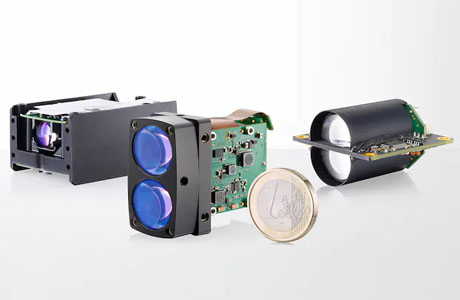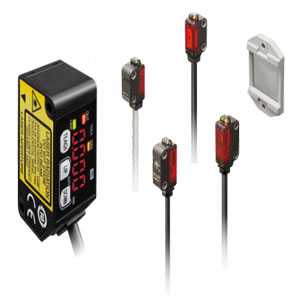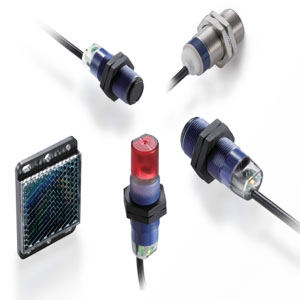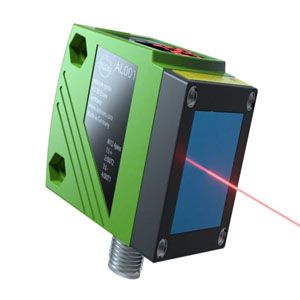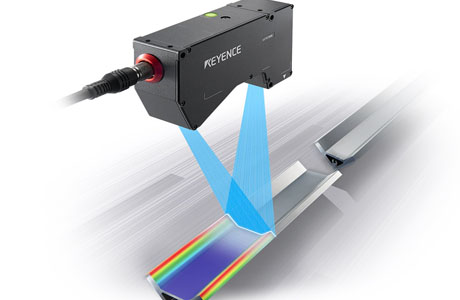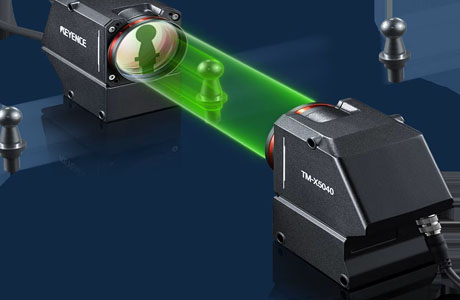
Laser Sensors: All Types and How They Works
What will you learn in this Blog?
- What is a laser sensor?
- Types of Laser Sensors
- Features of laser sensor
- The working principle of laser sensors
- Functions of laser sensor
- Laser Sensor Application
- Advantages and Disadvantages
- How laser sensors are used?
More & More…
Introduction
Laser sensors revolutionize industries with precision, non-contact measurement, and versatile applications. Versatile laser sensors are vital for quality control, robotics, and industry applications.
This blog examines laser sensors, their functions, features, types, and pros/cons. We explore laser sensors’ applications in automation, robotics, healthcare, security, and more. Discover how laser sensors transform industries and drive technological advancements.
What is a Laser Sensor?
A laser sensor is a device that uses laser technology to measure distance and detect objects. Laser sensors provide precise measurements by analyzing reflected laser beams. Laser sensors find extensive usage in manufacturing and robotics. Automation for accurate non-contact measurements.
Importance of Laser Sensors in Various Industries
Laser sensors revolutionize industries, enhancing efficiency and transforming processes. In manufacturing, laser sensors enable precise measurement and quality control, ensuring product consistency.
Laser sensors in robotics offer precise position feedback, enhancing safety and movement. They are vital in the automotive industry for collision avoidance systems. Laser sensors are also used in aerospace for navigation and obstacle detection.
Their applications extend to healthcare, where they aid in diagnostics and surgical procedures. Laser sensors are vital for industries, enhancing productivity and ensuring reliable results.
Types of Laser Sensors
A. Distance Measurement Sensors
1. Time-of-Flight (ToF) Sensors
Distance measurement sensors are essential laser sensors in various industries. One prominent type is the Time-of-Flight (ToF) sensor. These sensors measure distance by timing laser pulse travel to the target.
ToF sensors enable precise distance calculations in robotics, automation, and 3D scanning. ToF sensors are vital for accurate distance measurement and object detection in industries.
2. Triangulation Sensors
Triangulation sensors are commonly used in laser technology for distance measurement. It uses triangulation to measure object distance. A laser beam is projected onto the target, and the reflected beam is captured by a sensor.
Triangulation sensors determine distance using the reflected beam’s position analysis. It provides accurate distance measurements in automation, inspection, and alignment.
3. Confocal Sensors
Confocal sensors use microscopy principles for distance measurement. It measures reflected light intensity with a focused laser beam. It is analyze reflected light intensity for accurate distance determination.
Confocal sensors offer precise measurements on varying reflective surfaces. These are used in microscopy, surface profiling, and quality control in various industries.
B. Position and Displacement Sensors
1. Interferometric Sensors
Interferometric sensors use the interference principle for position and displacement measurement. It analyzes laser beam interference to measure object position or displacement. Interferometric sensors provide exceptional precision, detecting a subtle position or displacement changes.
Interferometric sensors are vital in nanotechnology, precision engineering, and optical metrology. It is invaluable in science and industry for exceptional accuracy.
2. Laser Doppler Velocimetry (LDV) Sensors
Laser Doppler Velocimetry (LDV) sensors measure object velocity for position and displacement. It uses the Doppler effect to measure the velocity of moving targets. It determines object velocity by analyzing frequency shifts.
LDV sensors offer precise and non-intrusive velocity measurements in fluid dynamics and automotive. LDV sensors are valuable in scientific and engineering applications for measuring flow rates.
3. Laser Triangulation Sensors
Laser triangulation sensors measure distance and position using triangulation principles. These sensors emit a laser beam onto a target surface, and a receiver detects the reflected beam. It is determine distance and position by analyzing reflected beams.
They are widely used in industries such as manufacturing, and robotics. Automation for applications such as dimensional inspection and position feedback. It provides accuracy and versatility in industrial applications.
C. Level and Proximity Sensors
1. Capacitive Sensors
Capacitive sensors detect object presence or level through capacitance changes. It detects objects by altering the electric field’s capacitance. They are commonly used for object detection, liquid-level sensing, and touch-sensitive interfaces. These are valuable in automotive, food processing. Electronics due to non-contact operation and material detection.
2. Photoelectric Sensors
Photoelectric sensors detect object presence or absence using light. It measures reflected/transmitted light intensity after emitting a light beam. When an object interrupts the light beam, it triggers a response.
Photoelectric sensors are widely used for object detection, part counting, and automation applications. They offer versatility, long sensing ranges, and resistance to environmental factors. Making them valuable in industries such as packaging, material handling, and industrial automation.
3. Fiber-Optic Sensors
Fiber-optic sensors detect light transmission changes using optical fibers. These sensors consist of an optical fiber that carries light to and from the sensing area. It responds to object interaction by changing light transmission.
Fiber-optic sensors provide high sensitivity and resilience in challenging environments. Fiber-optic sensors are essential for reliable sensing in aerospace, oil, and gas.
high precision and accuracy
Laser sensors are renowned for their high precision and accuracy in measurement. Advanced technology and focused laser beams enable precise and reliable positioning and measurement.
These are invaluable in precise measurement industries like manufacturing, robotics, and quality control. Accurate laser sensor results enhance efficiency and product quality across applications.
Non-contact measurement
A key advantage of laser sensors is non-contact measurement capability. Laser sensors measure without contact, unlike traditional methods requiring physical contact.
Non-contact measurement laser sensor minimizes object damage and sensor wear, preserving delicate items. Laser sensors’ non-contact measurement is versatile and suitable for challenging environments.
Wide range of operating distances
Laser sensors measure objects at different distances with a wide operating range. It offers high-accuracy measurements for both short and long distances.
Laser sensors are versatile, serving diverse industries with close proximity and long-distance applications. It is wide operating range ensures versatility for diverse measurement needs.
Fast response time
Laser sensors provide quick and real-time measurements with fast response time. It offers fast data acquisition and processing for immediate feedback and decision-making.
Real-time monitoring applications benefit from laser sensors’ fast feedback and control. Laser sensors’ fast response time enhances efficiency and productivity in multiple industries.
Ability to measure various materials and surfaces
Laser sensors accurately measure diverse materials and surfaces. It can measure various materials like metals, plastics, glass, and fabrics. Moreover, laser sensors can accurately measure surfaces with varying textures, reflectivity, and colors.
Laser sensors’ versatility finds applications in manufacturing, construction, and agriculture. It is measuring diverse materials and surfaces.
Laser Sensor Working Principle
Emission of Laser Beam
Laser sensors work by emitting a laser beam as a fundamental principle. The sensor emits a highly focused and coherent laser beam towards the target object.
The laser beam acts as a precise and focused light source during interaction with the target. The emission stage is crucial for laser sensors’ measurement process.
Interaction with the Target
After the laser beam is emitted, it interacts with the target object. The laser beam reacts based on target material and surface properties. This interaction alters the properties of the laser beam, such as its intensity, phase.
Analyzing the interaction provides valuable measurements like distance, position. The interaction stage is crucial for the subsequent analysis and measurement process.
Detection and Analysis of Reflected Light
The laser sensor detects and analyzes the reflected light after interaction. The sensor measures characteristics of the reflected light beam, such as intensity.
The measurements provide data to calculate distance, position, and other parameters. It is extract information from reflected light for precise measurements.
Calculation of Distance or Position
After analyzing the reflected light, the laser sensor calculates the target object’s distance. Calculation involves using laser beam properties and reflected light characteristics.
By comparing emitted and reflected light, the sensor calculates accurate distance or position. Laser sensors deliver precise measurements across various applications using sophisticated algorithms.
Functions of Laser Sensors
Distance measurement
One of the primary functions of laser sensors is distance measurement. High precision and non-contact measurements accurately determine target distance.
Reliable distance data is essential in robotics, automation, surveying, and construction. Accurate distance measurements benefit industries in positioning and monitoring objects.
Position and displacement sensing
Laser sensors excel at position and displacement sensing tasks. Accurate object measurements provide valuable feedback in automation, robotics, and precision engineering.
Precise control of object movements and positioning is enabled in diverse industries. High accuracy and fast response enable precise positioning and real-time adjustments.
Level and proximity detection
Laser sensors are commonly used for level and proximity detection applications. They detect object presence, absence, or level without physical contact. In level detection, laser sensors can monitor and measure the height or depth of liquids.
For proximity detection, objects are detected within a specific range. These functions support efficient control and monitoring in manufacturing and packaging industries.
Object detection and recognition
Laser sensors are widely utilized for object detection and recognition purposes. Object detection and differentiation contribute to automation and robotics systems.
They aid in identifying and categorizing objects based on their shape, size. Accurate object detection enhances efficiency and safety in automation, security, and autonomous vehicles.
Laser Sensor Applications
Industrial Automation
Laser sensors find extensive applications in industrial automation. They enable precise positioning, object detection, and quality control in manufacturing processes.
Robotic guidance and material handling improve efficiency and accuracy in production lines. Precision, non-contact measurement, and fast response enhance industrial automation productivity and reliability.
Robotics and Manufacturing
Laser sensors play a crucial role in robotics and manufacturing industries. Laser sensors aid robot navigation, obstacle detection, and precise positioning.
They provide real-time feedback and enable robots to interact with their environment effectively. In manufacturing, laser sensors aid in quality control, dimensional inspection, and alignment tasks.
Accurate measurements, defect detection, and product verification enhance quality and efficiency. In enhancing automation and robotics in manufacturing, laser sensors are essential.
Automotive Industry
The automotive industry extensively utilizes laser sensors for various applications. Collision avoidance systems utilize object detection for driver proximity warnings. They enhance ADAS capabilities with adaptive cruise control and lane departure warning.
In autonomous vehicles, LIDAR sensors map surroundings and provide real-time navigation data. Laser sensors enhance automotive safety and enable autonomous capabilities.
Aerospace and Aviation
Laser sensors have significant applications in the aerospace and aviation industry. Laser tech boosts aircraft and spacecraft safety, and efficiency through navigation and detection.
They enable precise position and distance measurements during landing approaches and docking procedures. Laser sensors ensure aerospace safety and reliability through accurate data acquisition.
Healthcare and Biomedical
Laser sensors have valuable applications in the field of healthcare and biomedical. Medical imaging systems utilize lasers to capture detailed tissue images for diagnostics. It detects subtle movements, aiding in monitoring vital signs.
Laser sensors provide precise measurements and feedback during surgical procedures. It enhances patient care, diagnostics, and biomedical research through advancements.
Security and Surveillance
Laser sensors play a significant role in security and surveillance systems. Laser technology safeguards perimeters, detects access, and enables precise virtual detection zones. They contribute to the identification and tracking of intruders or suspicious activities. It boosts security systems with reliable real-time detection indoors and outdoors.
Advantages and Disadvantages
Advantages of Laser Sensors
High accuracy and precision
Laser sensors offer high accuracy and precision in measurement. Their advanced technology and focused laser beams ensure reliable and precise data acquisition. Laser sensors excel in precise positioning, distance measurement, and object detection applications. It improves quality control and boost productivity in diverse industries.
Non-contact measurement
One of the significant advantages of laser sensors is non-contact measurement. It measures without contact, unlike traditional methods.
Non-contact measurement avoids object damage and reduces sensor wear and tear. Non-contact measurement suits challenging environments, expanding laser sensor applications.
Wide operating range
Laser sensors adapt to different measurement needs with a wide operating range. Accurate measurements at short and long distances offer flexibility.
Versatility suits diverse industries and scenarios. Precise and reliable measurements enhance their value.
Fast response time
Laser sensors boast a fast response time, allowing for quick and real-time measurements. It is deliver quick feedback for swift decision-making. Real-time monitoring benefits from their fast response time.
Operational efficiency and system performance are improved. Fast response time aids automation, robotics, and high-speed manufacturing.
Versatile applications
Laser sensors are versatile for diverse industries and tasks. They can be employed in manufacturing, robotics, automation, healthcare, security, and more.
Laser sensors excel in distance measurement, position sensing, object detection, and level monitoring. Versatility addresses diverse needs and challenges. Indispensable tools across multiple sectors and applications.
Disadvantages of Laser Sensors
High cost
The disadvantage is the High cost compared to alternatives. The reasons are Advanced components, precision manufacturing, and calibration.
Additional expenses are Specialized expertise and maintenance. Positive trends are Cost decreasing due to advancements, and adoption.
Susceptibility to environmental factors
Laser sensors are susceptible to environmental factors that can affect their performance.
External factors affect laser beam accuracy: dust, smoke, fog, and reflective surfaces.
Extreme temperatures or humidity levels may also impact the sensor’s operation. To mitigate these challenges, proper environmental conditions, regular maintenance, and calibration are necessary.
Consider environmental factors for reliable measurements. Select suitable laser sensors or implement mitigation measures. Ensure accuracy by minimizing environmental impact.
Limited performance on certain surfaces
Laser sensors may exhibit limited performance on certain surfaces.
Challenges with materials: Transparent or highly reflective surfaces. Transparent objects transmit, not reflect, laser beams.
Highly reflective surfaces cause interference or glare. Consider material properties for optimal sensor performance.
Complexity of setup and calibration
The setup and calibration of laser sensors can be complex, requiring specialized knowledge.
Achieving accuracy involves correct alignment, parameter calibration, and system integration.
Challenges arise during installation and setup changes. Advancements make processes streamlined and user-friendly.
Uses of Laser Sensors
Industrial Processes and Quality Control
Laser sensors are extensively used in industrial processes and quality control. Precise measurements ensure accurate positioning and alignment in manufacturing processes. Quality control checks employ sensors for defect detection, product verification, and process monitoring.
They contribute to improving production efficiency, reducing errors, and enhancing overall product quality. Laser sensors are vital for maintaining and optimizing industrial processes in manufacturing.
Robotics and Automation
Laser sensors have significant applications in robotics and automation. They enable precise navigation, obstacle detection, and object recognition in robotic systems. Laser sensors provide real-time feedback, enabling accurate task performance by robotic platforms.
Laser sensors guide autonomous robots for safe and efficient movements. Advanced robotics and automation, improving productivity, safety, and capabilities.
Material Handling and Logistics
Laser sensors are widely used in material handling and logistics applications. They aid in automated inventory management, tracking, and positioning of goods in warehouses. It provides precise measurements for pallet positioning, conveyor control, and package sorting.
It optimizes material flow, improving logistics efficiency and reducing errors. Laser sensors streamline material handling in industries like e-commerce, manufacturing, and logistics.
Monitoring and Surveillance Systems
Laser sensors find extensive use in monitoring and surveillance systems. They accurately detect and track moving objects indoors and outdoors. Laser sensors can be employed in security systems, perimeter monitoring, and traffic management.
They contribute to effective surveillance by providing reliable data on object presence, and movement. Laser sensors enhance the capabilities of monitoring and surveillance systems. It is ensuring efficient and precise monitoring for safety and security purposes.
Medical Diagnostics and Imaging
Laser sensors have significant applications in medical diagnostics and imaging. It assists in medical imaging techniques like OCT for detailed tissue imaging.
Sensors aid in monitoring vital signs, detecting movements, and ensuring surgical precision. High precision and non-contact measurement capabilities make them invaluable in medical applications. Advancing patient care and diagnostics.
Research and Development
Laser sensors are widely utilized in research and development activities. It assists in scientific experiments and data analysis in physics, and chemistry.
Laser sensors enable precise measurements for material properties, system behavior, and phenomena analysis. It is valuable tool for researchers, supporting advancements across disciplines.
Conclusion:
Laser sensors are versatile and invaluable tools in various industries. Laser sensors are essential in industrial processes, robotics, healthcare, and security. It offers advantages but consider cost and environmental factors.
However, the benefits they bring to automation, efficiency, and safety outweigh these limitations. Laser sensors drive innovation and improve industry processes with advancing technology. It enables enhanced accuracy, reliability, and productivity in diverse sectors.

